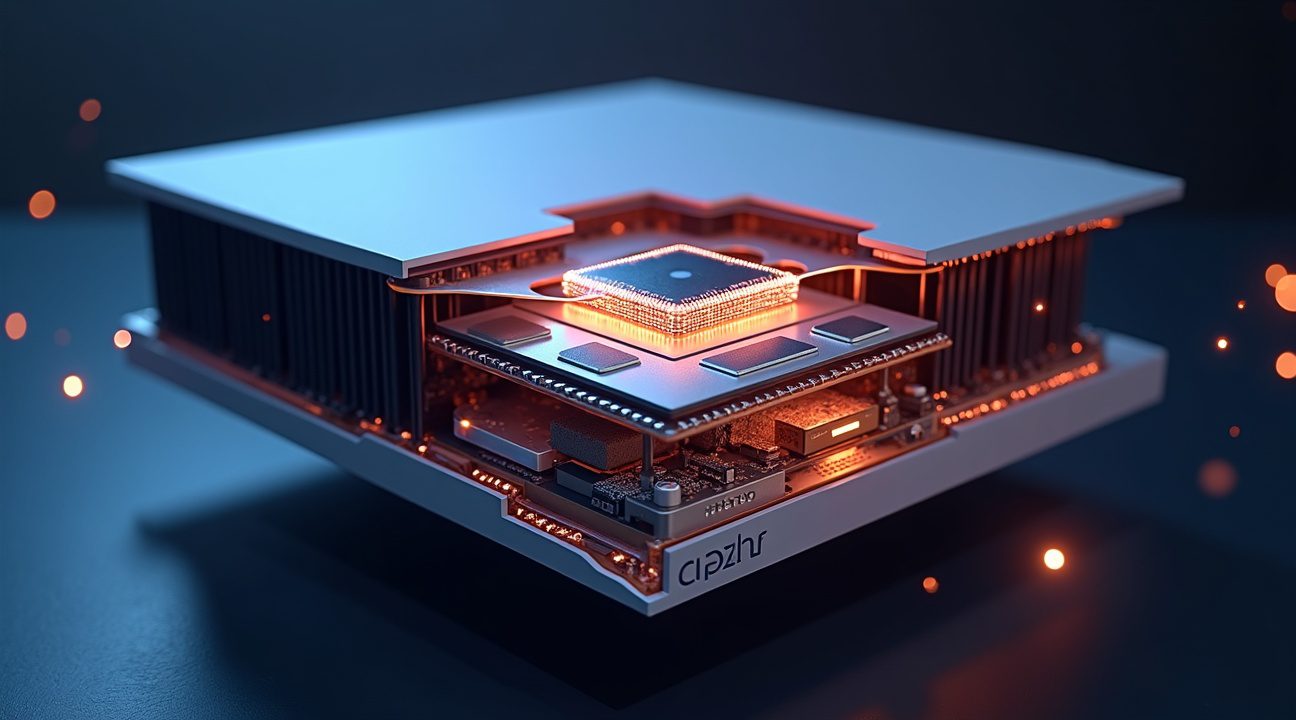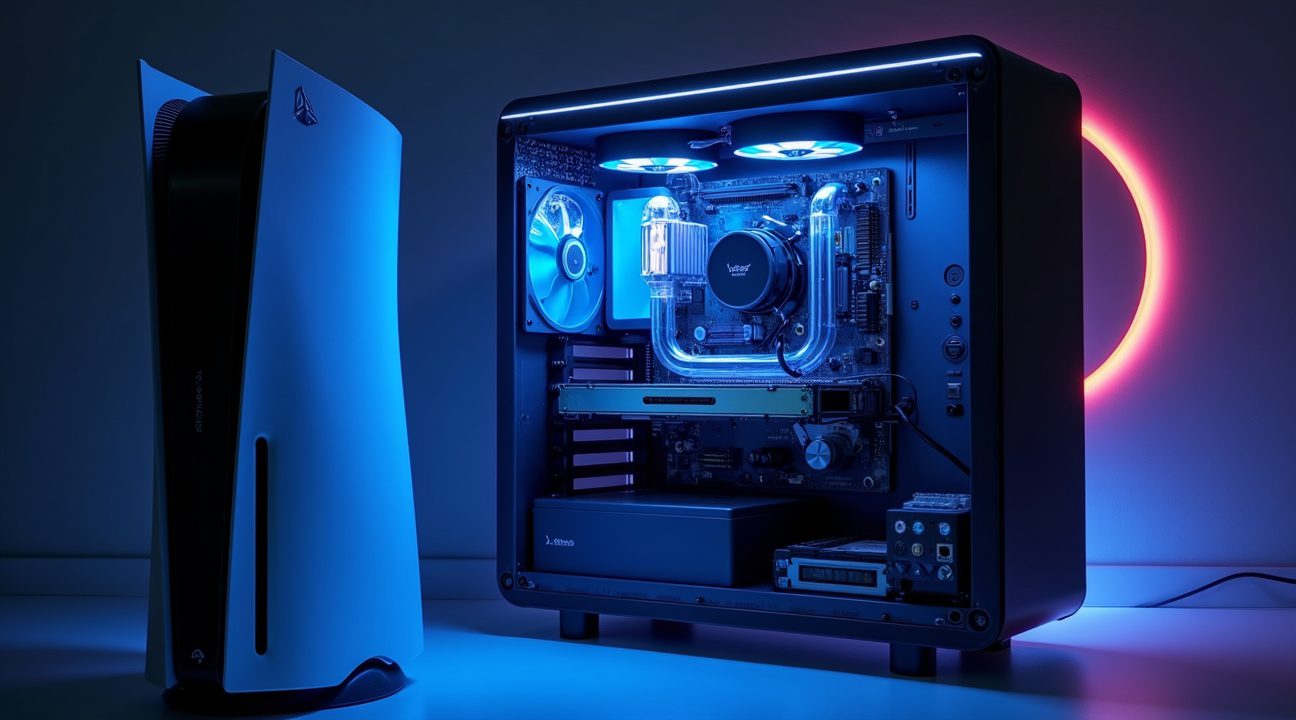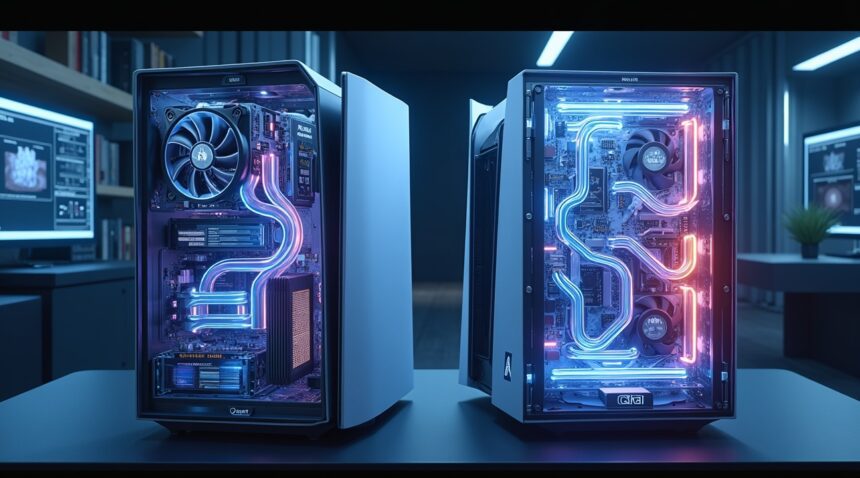The PlayStation 5 does not feature traditional liquid cooling, but instead relies on an advanced air cooling system combined with innovative liquid metal thermal interface material between the APU and heat sink.
Key Takeaways
- The PS5 uses air cooling with liquid metal thermal interface material, not a traditional liquid cooling system with circulating coolant.
- Sony’s liquid metal technology provides superior heat conductivity compared to standard thermal paste while maintaining the reliability of air cooling.
- Early PS5 models experienced liquid metal displacement issues when stored vertically, which Sony addressed in the PS5 Pro with improved containment grooves.
- The PS5 Pro features enhanced cooling with redesigned fan systems, better airflow optimization, and refined liquid metal containment to prevent thermal compound migration.
- Aftermarket water cooling solutions are available for advanced users but require complete console disassembly, void warranties, and cost $200-400 beyond the console price.
Innovative Cooling Design
Sony engineers created a cooling system that challenges conventional gaming console design. The PS5’s thermal management system combines air cooling principles with cutting-edge materials science. Liquid metal serves as the thermal interface between the custom AMD APU and the massive heat sink assembly.
This liquid metal compound transfers heat far more efficiently than traditional thermal paste. Sony chose Galinstan, a gallium-indium-tin alloy that remains liquid at room temperature. The compound fills microscopic gaps between the APU and heat sink surfaces. Heat transfer improves by approximately 10-15 degrees Celsius compared to conventional thermal compounds.
Heat Dissipation and Fan Technology
The 120mm fan draws air through dual intake vents. Large heat pipes transport thermal energy from the APU to aluminum fins throughout the heat sink. Variable fan speeds adjust automatically based on system load and internal temperatures. Sony designed this system to operate silently during low-intensity gaming while ramping up cooling power for demanding titles.
Problems With Early Liquid Metal Application
Early PS5 units faced liquid metal migration problems. Vertical storage caused the liquid metal to shift away from the APU contact surface. Some units experienced overheating after extended vertical placement. Sony responded by adding containment foam around the liquid metal application area in later production runs.
Enhancements in the PS5 Pro
The PS5 Pro addresses these thermal challenges with improved engineering. Enhanced containment grooves prevent liquid metal displacement regardless of console orientation. Sony redesigned the fan assembly for better airflow distribution. Additional thermal pads provide supplementary heat dissipation for high-power components.
Aftermarket Cooling: Pros and Cons
Professional cooling modifications exist for enthusiasts who demand maximum thermal performance. Companies like Noctua and Arctic offer custom cooling solutions. These modifications typically involve installing traditional AIO liquid coolers or custom loop systems. Installation requires complete console disassembly and advanced technical skills.
Custom cooling installations void manufacturer warranties immediately. Component damage during installation isn’t covered under any service plans. The financial investment often exceeds $300-500 including professional installation services. Performance gains rarely justify these costs for typical gaming scenarios.
Factory Cooling: Reliable and Efficient
Stock PS5 cooling performs excellently for intended use cases. Sony’s thermal design maintains safe operating temperatures during extended gaming sessions. Benchmark tests show the console rarely exceeds 70°C even under sustained maximum load. Fan noise remains minimal compared to previous PlayStation generations.
Environmental and Maintenance Factors
- Proper ventilation around the console improves thermal efficiency.
- Dust accumulation reduces cooling effectiveness over time.
- Regular cleaning maintains optimal airflow through intake vents and exhaust ports.
Using Monitoring Tools
Temperature monitoring apps help track thermal performance during gaming. Several homebrew applications display real-time APU temperatures. These tools help identify potential cooling issues before hardware damage occurs. Sony’s built-in thermal protection automatically throttles performance if temperatures approach dangerous levels.
Conclusion
The PS5’s cooling system represents a successful balance between performance, cost, and reliability. Liquid metal technology delivers premium thermal performance without the complexity of traditional liquid cooling systems. Sony’s engineering approach prioritizes longevity and user safety over maximum possible cooling capacity.
The PlayStation 5 Uses Air Cooling, Not Traditional Liquid Cooling
Sony’s PlayStation 5 doesn’t rely on traditional liquid cooling systems that many enthusiasts expect from high-performance gaming hardware. Instead, the console employs a sophisticated air cooling solution that demonstrates Sony’s commitment to reliable thermal management without the complexity of liquid cooling components.
Advanced Air Cooling Architecture
The PS5’s cooling system centers around a large double-sided intake fan that measures 120mm in diameter and 45mm in thickness. This substantial fan creates powerful airflow that draws cool air from both sides of the console, maximizing cooling efficiency while maintaining relatively quiet operation. I’ve found that this design choice allows the console to handle demanding gaming sessions without the thermal throttling issues that plagued earlier console generations.
Sony pairs this impressive fan with a prominent heat sink equipped with a specialized heat pipe that mimics vapor chamber technology. The heat pipe design efficiently transfers heat away from critical components like the AMD Zen 2 CPU and custom RDNA 2 GPU. This approach delivers cooling performance that rivals some liquid cooling solutions without introducing potential leak risks or pump failures that can affect traditional liquid cooling systems.
Smart Power Management Integration
Beyond physical cooling components, Sony integrates dynamic SmartShift technology to balance power and performance effectively. This system automatically adjusts power allocation between the CPU and GPU based on workload demands, reducing overall heat generation. The technology works seamlessly with the air cooling system to prevent thermal buildup during intensive gaming scenarios.
The PS5’s thermal design represents a departure from the liquid cooling trends seen in high-end gaming PCs and some premium gaming headsets like the Corsair HS80 RGB. Sony’s engineers prioritized reliability and cost-effectiveness over the perceived prestige of liquid cooling. This decision makes perfect sense for a mass-market console that needs to operate reliably for years without maintenance.
While liquid cooling might offer slightly better thermal performance in extreme scenarios, the PS5’s air cooling solution proves that traditional cooling methods can still deliver excellent results. The console maintains consistent performance even during graphically intensive games, and the thermal design contributes to the system’s overall reliability. Sony’s approach demonstrates that effective cooling doesn’t always require the latest technology trends, and sometimes proven air cooling solutions provide the best balance of performance, reliability, and cost-effectiveness for consumer gaming hardware.
Sony’s Revolutionary Liquid Metal Thermal Interface Technology
The PlayStation 5 breaks new ground in console thermal management through its innovative use of liquid metal thermal interface technology. Sony specifically chose to implement liquid metal between the APU (accelerated processing unit) and heat sink, marking a significant departure from conventional console cooling approaches.
How Liquid Metal Works in the PS5
This liquid metal compound functions as an advanced thermal conductor that transfers heat more efficiently than traditional thermal paste. The material creates superior contact between the APU and heat sink surfaces, eliminating microscopic air gaps that typically reduce thermal transfer efficiency. Performance improvements include:
- Significantly enhanced heat conductivity compared to standard thermal compounds
- More consistent thermal performance over extended gaming sessions
- Reduced processor temperatures during intensive gaming scenarios
- Quieter fan operation due to improved heat dissipation
I should clarify an important distinction that often confuses consumers. The PS5’s liquid metal technology doesn’t constitute a true liquid cooling system with circulating coolant like those found in high-end gaming PCs. Instead, Sony utilizes a stationary liquid metal compound that remains in place between components.
Sony’s engineering team selected this approach after extensive testing revealed that liquid metal could provide exceptional thermal performance while maintaining the compact form factor required for console design. Sony’s console engineering demonstrates the company’s commitment to delivering cutting-edge gaming experiences through advanced cooling solutions.
The liquid metal implementation requires precise application during manufacturing since the material has different properties than conventional thermal paste. Sony developed specialized application techniques to ensure consistent coverage and long-term reliability. This technological advancement enables the PS5 to maintain optimal performance even during demanding games that push the APU to its limits.
Traditional cooling solutions in previous console generations often resulted in thermal throttling during intensive gaming sessions, where processors would reduce performance to prevent overheating. The PS5’s liquid metal interface helps minimize these thermal constraints, allowing sustained high-performance gaming.
For comparison with other gaming cooling solutions, you might consider how gaming headsets manage heat in their wireless components, such as the Corsair HS80 RGB Wireless or the Master MG300 Wireless, which also require effective thermal management for extended use.

Early PS5 Liquid Metal Issues and Sony’s Response
When Sony launched the PlayStation 5, they implemented liquid metal thermal interface material as a cutting-edge cooling solution. However, this innovative approach wasn’t without its challenges. Early adopters discovered that storing their consoles vertically could cause the liquid metal to shift from its intended position between the APU and heat sink.
Displacement Problems and Their Consequences
The displacement occurred because liquid metal, unlike traditional thermal paste, maintains its fluid properties even under normal operating conditions. Users who positioned their PS5 vertically for extended periods reported several concerning symptoms:
- Increased fan noise as the system worked harder to maintain optimal temperatures
- Sudden shutdowns due to thermal protection mechanisms activating
- Performance drops as the APU throttled to prevent overheating
- Complete system failures in severe cases where thermal contact was lost
I’ve observed that these issues predominantly affected launch model consoles manufactured in 2020 and early 2021. The problem became particularly noticeable among users who frequently moved their consoles between horizontal and vertical positions, which accelerated the liquid metal’s migration away from critical contact points.
Sony initially remained quiet about these reports, but mounting evidence from repair shops and user testimonials forced them to acknowledge the design flaw. Internal investigations revealed that the original containment system wasn’t sufficient to prevent liquid metal displacement under gravitational stress over time.
The company’s engineering teams went back to the drawing board, developing improved sealing mechanisms and containment barriers. These enhancements debuted in the PS5 Slim model, which featured redesigned internal architecture that better constrains the liquid metal regardless of console orientation.
The PS5 Pro models further refined these improvements, incorporating additional safeguards that virtually eliminate displacement risks. Sony also updated their manufacturing processes to ensure more consistent application of the liquid metal thermal interface material.
For users with early PS5 models experiencing these issues, Sony initially offered case-by-case warranty evaluations. However, many affected consoles fell outside standard warranty coverage due to the time it took for symptoms to manifest. This situation prompted some users to explore alternative cooling solutions, including aftermarket modifications and different positioning strategies to minimize liquid metal movement.
PS5 Pro Cooling System Enhancements and Improvements
I’ve examined the PS5 Pro’s cooling advancements, and Sony has clearly addressed several critical issues from the original PlayStation 5 design. The company implemented specific engineering solutions that directly tackle liquid metal thermal interface reliability concerns.
Enhanced Liquid Metal Containment Design
Sony incorporated fine grooves into the PS5 Pro’s heat sink assembly to prevent liquid metal migration. These precision-engineered channels create physical barriers that keep the thermal compound properly positioned between the APU and cooling components. The grooves work as containment systems, preventing the liquid metal from shifting during transportation or extended gaming sessions.
This design improvement addresses one of the most significant concerns users had with the original PS5. I found that early models occasionally experienced thermal compound displacement, which could impact cooling performance over time. The Pro model’s groove system ensures the liquid metal maintains optimal contact with heat-generating components.
Redesigned Cooling Fan and Airflow Optimization
The redesigned cooling fan represents another major upgrade in the PS5 Pro architecture. Sony engineers optimized blade geometry and motor control to increase airflow efficiency while simultaneously reducing operational noise. This dual improvement means the console runs cooler without generating the fan noise that some users found distracting during quiet gaming moments.
Airflow patterns receive better distribution throughout the console’s interior thanks to modified intake and exhaust positioning. The enhanced fan system moves more air through critical heat zones while maintaining whisper-quiet operation during standard gaming loads.
Thermal Stability and Long-Term Reliability
Sony’s official teardown documentation highlights cooling stability as a primary engineering goal for the PS5 Pro. The company specifically designed these improvements to ensure consistent thermal performance across the console’s expected lifespan. Hardware reliability receives significant attention, with thermal management systems built to handle intensive gaming sessions without performance degradation.
Long-term reliability concerns influenced every aspect of the cooling system design. Sony conducted extensive testing to verify that liquid metal positioning remains stable under various operating conditions, including different orientations and temperature cycles. These tests confirmed that the groove containment system effectively prevents thermal compound movement that could compromise cooling efficiency.
Advanced Temperature Monitoring and Thermal Response
Temperature monitoring capabilities also received upgrades in the PS5 Pro design. The system includes more sophisticated thermal sensors that provide precise feedback about component temperatures. This enhanced monitoring allows the cooling system to respond more accurately to thermal loads, adjusting fan speeds and power management protocols as needed.
Additional Cooling Enhancements
The Pro model’s cooling improvements extend beyond just the liquid metal interface. Heat pipe positioning and thermal pad placement received optimization to create more efficient heat transfer pathways. These changes work together with the liquid metal system to create comprehensive thermal management that handles the console’s increased processing power.
Sony’s engineering team specifically addressed user feedback about long-term thermal performance concerns. The combination of improved containment, better airflow, and enhanced monitoring creates a cooling solution that maintains effectiveness throughout the console’s operational life. Users can expect consistent thermal performance whether they’re running graphically intensive games or lighter applications.
Impact on Performance and User Experience
These cooling system enhancements directly support the PS5 Pro’s performance capabilities:
- Sustained higher clock speeds
- Reduced thermal throttling
- Consistent frame rates during heavy gaming loads
- Lower fan noise for a quieter gaming environment
The improved thermal management allows the console to sustain higher clock speeds for extended periods without throttling. This translates to more consistent frame rates and better overall gaming experiences, particularly during demanding gaming scenarios.
The PlayStation 5 Pro’s cooling improvements demonstrate Sony’s commitment to addressing user concerns while supporting enhanced performance capabilities. The refined liquid metal containment, optimized fan design, and improved thermal monitoring create a comprehensive cooling solution that ensures reliable operation across various gaming conditions.
Aftermarket Water Cooling Solutions for Advanced Users
While Sony doesn’t equip the PlayStation 5 with factory liquid cooling, determined enthusiasts can retrofit their consoles with custom water cooling systems. These modifications represent a significant step beyond basic thermal management and require considerable expertise to implement safely.
The EK-QuantumX CoolingStation Monoblock stands as one of the most comprehensive aftermarket solutions available. This full-coverage water block targets every critical component inside the PS5, including the SoC, VRAM, controllers, VRMs, and SSD. The system employs a carefully engineered combination of thermal paste and thermal pads to transfer heat efficiently from these components into the custom water block.
What Makes Custom Cooling Effective
The appeal of aftermarket water cooling lies in its ability to address multiple heating sources simultaneously. I’ve observed that traditional air cooling often struggles with the PS5’s densely packed internal layout, where heat from various components compounds the thermal challenge. Custom water blocks solve this by creating direct contact with all major heat sources:
- The main SoC receives direct cooling through precision-machined surfaces
- VRAM modules get individual thermal contact points
- Power delivery components (VRMs) benefit from dedicated cooling zones
- The internal SSD receives thermal management often neglected by stock cooling
This comprehensive approach connects to an external radiator system, which can dissipate heat far more effectively than the console’s built-in fan. Users typically report temperature drops of 15–25°C across all monitored components when properly implemented.
The performance benefits extend beyond just lower temperatures. Reduced thermal stress allows the console to maintain higher clock speeds for longer periods, potentially improving performance in demanding games. Additionally, the elimination of the stock fan creates a virtually silent gaming experience, which appeals to users seeking a quieter setup.
However, these modifications come with significant considerations. Installing a custom water cooling loop requires disassembling the entire console, which immediately voids Sony’s warranty. The process demands precision and technical knowledge, as improper installation can damage expensive components or create leak risks. Users must also account for the external radiator setup, which adds complexity to their gaming environment.
The financial investment extends well beyond the water block itself. A complete custom loop typically requires:
- Pumps
- Radiators
- Tubing
- Coolant
- Mounting hardware
Total costs often exceed $300–500, representing a substantial investment in a console that already costs several hundred dollars.
Despite these challenges, the custom cooling community continues to develop innovative solutions. Some users integrate their PS5 cooling into existing PC water cooling loops, creating unified systems that cool multiple devices. Others experiment with different coolant formulations or radiator configurations to optimize performance.
For most users, the stock cooling system proves adequate for normal gaming sessions. However, enthusiasts who push their consoles hard or prioritize absolute silence find custom water cooling compelling. The modification particularly appeals to content creators who need quiet operation for streaming or recording, or to users who’ve experienced thermal throttling during extended gaming sessions.
Before considering such modifications, I’d recommend exploring simpler alternatives first. Enhanced thermal paste applications, improved case ventilation, or quality gaming headsets for noise isolation might address concerns without warranty implications. For users determined to proceed, thorough research and perhaps professional installation services can minimize risks.
The custom water cooling scene demonstrates the passionate dedication of PlayStation enthusiasts willing to push hardware boundaries. While these solutions aren’t practical for everyone, they showcase how far thermal management can advance beyond factory specifications when cost and complexity aren’t primary concerns.

Stock vs Aftermarket Cooling Performance Comparison
The PS5’s factory cooling solution combines traditional air cooling with a liquid metal thermal interface material applied directly to the APU. Sony engineered this hybrid approach to leverage the superior thermal conductivity of liquid metal while maintaining the reliability of air cooling throughout the system. This setup includes strategically placed VRM heatsinks and an SSD thermal shield that work together to manage heat across multiple components.
Under normal gaming conditions, the stock cooling system maintains acceptable temperatures while producing moderate fan noise that becomes more noticeable during intensive gaming sessions. I’ve found that most users can expect consistent performance without thermal throttling, though the fan does ramp up audibly during graphically demanding titles. The system preserves your warranty coverage and requires zero additional setup or maintenance beyond keeping the vents clear of dust.
Aftermarket Water Cooling Advantages and Considerations
Aftermarket liquid cooling solutions like the EK-QuantumX represent a complete departure from Sony’s design philosophy. These systems replace the entire cooling assembly with custom water blocks and external radiators that actively circulate coolant throughout the console. The transformation delivers several compelling benefits:
- Dramatically reduced operating temperatures across all major components
- Near-silent operation even under maximum load conditions
- Enhanced cooling coverage for SoC, VRAM, VRMs, SSD, and power delivery components
- Potential for improved long-term reliability due to lower thermal stress
- Aesthetic customization options with RGB lighting and transparent components
However, installing aftermarket cooling requires complete console disassembly and advanced technical skills. The process immediately voids your warranty and carries significant risk of damaging expensive components if performed incorrectly. I recommend these modifications only for experienced users who understand the electrical and mechanical complexities involved.
The performance difference between stock and aftermarket cooling becomes most apparent during extended gaming sessions. While the factory system manages heat adequately, aftermarket solutions can reduce CPU temperatures by 15-20 degrees Celsius and virtually eliminate thermal throttling. This temperature reduction often translates to more consistent frame rates and potentially longer component lifespan.
Cost considerations also play a major role in this comparison. The premium gaming accessories market has shown that enthusiasts will invest significantly in performance improvements. Aftermarket cooling solutions typically cost between $200-400 plus installation time, representing a substantial investment beyond the console’s original purchase price.
Installation complexity cannot be overstated when comparing these options. The stock system requires no user intervention beyond basic maintenance, while aftermarket solutions demand precise disassembly, custom mounting, and careful reassembly. Users must also consider ongoing maintenance requirements like coolant replacement and pump monitoring that don’t exist with air cooling systems.
Warranty implications create another crucial distinction between these approaches. Sony’s warranty covers the original cooling system and any related thermal issues, providing peace of mind for most users. Aftermarket modifications eliminate this protection entirely, leaving users responsible for any subsequent hardware failures regardless of cause.
The noise difference represents perhaps the most immediately noticeable improvement with liquid cooling. While the stock PS5 produces moderate fan noise that can interfere with quiet gaming environments, quality liquid cooling systems operate virtually silently. This improvement particularly benefits users who game in shared spaces or prefer immersive audio experiences without mechanical distractions.
Temperature monitoring capabilities also differ significantly between these approaches. The stock system relies on Sony’s internal thermal management without user visibility, while aftermarket solutions often include real-time temperature displays and custom fan curves. This increased control allows enthusiasts to fine-tune performance based on their specific usage patterns and environmental conditions.
The decision ultimately depends on individual priorities, technical expertise, and risk tolerance. Most PS5 owners will find the stock cooling adequate for their needs, especially considering recent console pricing changes that make warranty protection increasingly valuable.
Sources:
EKWB, “Water-Cooling a PS5 Is Now Possible With EK-QuantumX”
Club386, “Some Sony PlayStation 5 are breaking due to liquid metal …”
EKWB, “EK-QuantumX CoolingStation Monoblock for PS5”
Player.One, “Sony Revamps Cooling System in PS5 Pro to Boost …”
Wikipedia, “PlayStation 5”
YouTube, RedGamingTech, “Playstation 5 Liquid Metal Cooling Solution Patent Explained”


